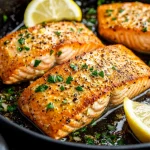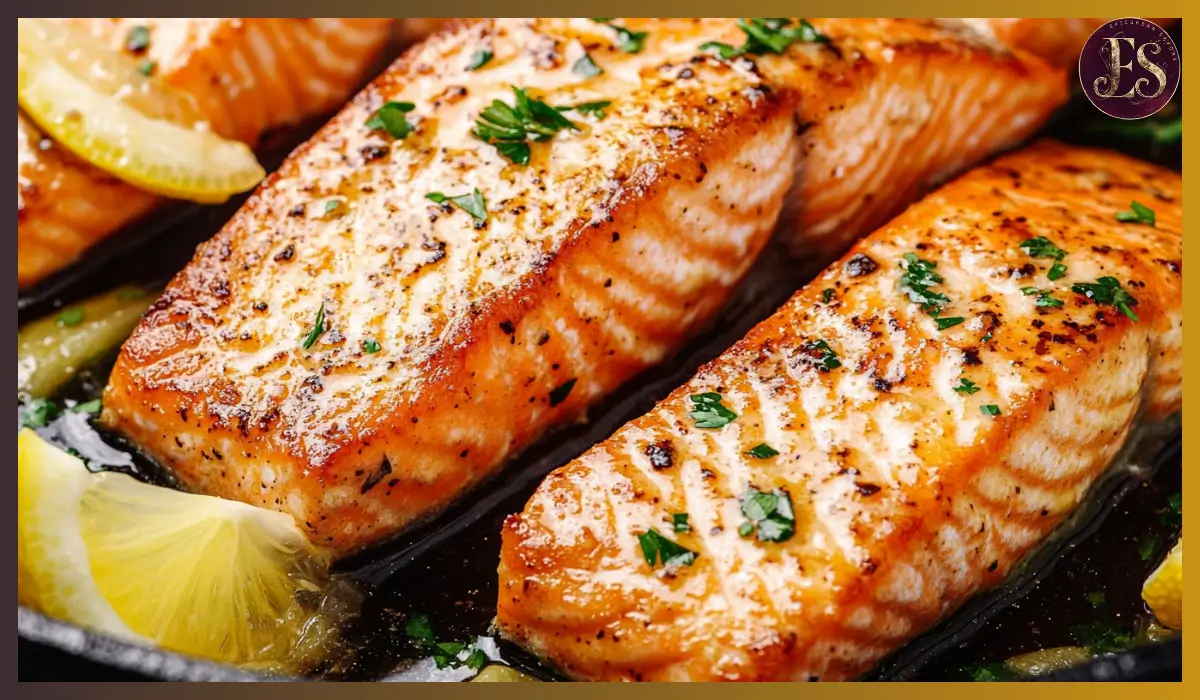There’s something magical about salmon cooked in a rich, garlicky butter sauce. It’s tender, flaky, and bursting with flavor, yet it comes together in just minutes. This garlic butter salmon recipe is the perfect combination of elegance and simplicity, making it ideal for everything from busy weeknight dinners to special date nights.
One of the best things about this recipe is that it requires minimal ingredients but delivers a restaurant-quality dish. The garlic butter sauce infuses the salmon with incredible richness, while a splash of fresh lemon juice brightens up the entire dish. If you’re looking for an easy way to elevate your salmon game, this recipe is exactly what you need.
I still remember the first time I made garlic butter salmon at home. I had always thought salmon was a tricky fish to cook, afraid that I’d overcook it and end up with something dry and tough. But after experimenting with different methods, I realized that salmon is one of the easiest proteins to cook. Once I learned the secret to a perfectly seared, juicy fillet, it became my go-to meal whenever I wanted something quick but impressive.
In this recipe, I’ll walk you through everything you need to know—from picking the best salmon fillets to cooking them to perfection. You’ll also get tips on how to make sure your garlic butter sauce is just the right consistency, along with serving suggestions to round out the meal. Whether you’re new to cooking salmon or a seasoned pro, this recipe is bound to become a favorite in your kitchen.
Why You’ll Love This Recipe
There are countless ways to cook salmon, but this garlic butter salmon stands out for several reasons.
1. Quick and Easy
This recipe requires only a handful of ingredients and minimal prep work. In less than 20 minutes, you’ll have a flavorful, restaurant-worthy dish ready to serve.
2. Packed with Flavor
The garlic butter sauce is the real star here. It’s rich, savory, and slightly tangy from the fresh lemon juice, which balances out the richness of the butter. Every bite is melt-in-your-mouth delicious.
3. Versatile and Customizable
This dish pairs well with just about anything. Serve it over rice, pasta, or with roasted vegetables for a well-rounded meal. You can also tweak the seasoning by adding red pepper flakes for heat or a touch of honey for sweetness.
4. Perfectly Cooked Salmon, Every Time
One of the biggest fears when cooking salmon is overcooking it, but with the right technique, your salmon will always be tender and flaky. I’ll share my foolproof method to ensure that your salmon turns out perfect every time.
5. Healthy and Nutritious
Salmon is packed with protein, healthy fats, and essential nutrients. This recipe allows you to enjoy a delicious meal without feeling weighed down.
Health Benefits of Salmon
Salmon is not just delicious—it’s one of the healthiest proteins you can eat. Let’s take a closer look at some of its impressive health benefits.
1. Rich in Omega-3 Fatty Acids
Salmon is one of the best sources of omega-3 fatty acids, which are essential for brain function, heart health, and reducing inflammation. Omega-3s have also been linked to improved mood and cognitive function.
2. High-Quality Protein Source
Each serving of salmon provides a generous amount of protein, which is essential for muscle growth, repair, and overall body function. If you’re looking for a high-protein meal that keeps you full for hours, salmon is an excellent choice.
3. Packed with Vitamins and Minerals
Salmon is loaded with important nutrients, including vitamin D, B vitamins, selenium, and potassium. Vitamin D is particularly important for bone health and immune function, while B vitamins help with energy production.
4. Supports Heart Health
Regular consumption of salmon has been linked to a reduced risk of heart disease. The healthy fats in salmon help lower bad cholesterol levels while increasing good cholesterol.
5. Good for Skin and Hair
The omega-3s and antioxidants in salmon contribute to healthy, glowing skin and strong hair. They help maintain skin elasticity, reduce dryness, and promote overall hydration.
Preparation Time, Servings, and Nutritional Information
Preparation and Cooking Time
- Prep Time: 5 minutes
- Cook Time: 10-12 minutes
- Total Time: 15-17 minutes
Servings
This recipe serves 4 people. If you’re cooking for fewer people, leftovers store well and can be used for other meals.
Nutritional Information (Per Serving)
- Calories: 420
- Protein: 35g
- Fat: 28g
- Carbohydrates: 3g
- Omega-3s: High
Ingredients List
- 4 salmon fillets (about 6 ounces each)
- 1 teaspoon salt
- ½ teaspoon black pepper
- 1 tablespoon olive oil
- 4 tablespoons unsalted butter
- 4 garlic cloves, minced
- 1 tablespoon fresh lemon juice
- 1 teaspoon lemon zest
- 1 teaspoon fresh parsley, chopped (optional)
Step-By-Step Cooking Instructions
1. Prepare the Salmon
Remove the salmon fillets from the refrigerator and let them sit at room temperature for about 15 minutes. This helps them cook evenly. Pat them dry with paper towels to remove excess moisture.
2. Season the Fillets
Sprinkle both sides of the salmon with salt and black pepper. If you prefer extra flavor, you can add a pinch of paprika or red pepper flakes.
3. Heat the Skillet
Place a large skillet over medium-high heat and add the olive oil. Once the oil is hot, add the salmon fillets skin-side down.
4. Sear the Salmon
Let the salmon cook undisturbed for about 4-5 minutes. You’ll know it’s ready to flip when the edges look golden brown and the fillet naturally releases from the pan. Flip the fillets carefully and cook for another 2-3 minutes on the other side.
5. Make the Garlic Butter Sauce
Reduce the heat to medium-low and add the butter to the skillet. Once melted, add the minced garlic and sauté for about 30 seconds until fragrant.
6. Add Lemon Juice and Zest
Stir in the fresh lemon juice and lemon zest, letting the sauce simmer for about 1 minute. This enhances the flavor and gives the salmon a bright, fresh taste.
7. Baste the Salmon
Spoon the garlic butter sauce over the salmon fillets repeatedly to infuse them with flavor.
8. Garnish and Serve
Remove the skillet from heat and sprinkle fresh parsley over the salmon. Serve immediately with your favorite sides.
How to Serve
- Over fluffy rice or quinoa for a hearty meal
- With roasted or steamed vegetables for a low-carb option
- Alongside mashed potatoes or garlic butter noodles
- In a salad with mixed greens, avocado, and a lemon dressing
Pairing Suggestions
- Side Dishes: Roasted asparagus, sautéed spinach, or baked sweet potatoes
- Beverages: Fresh lemonade, sparkling water with lime, or iced herbal tea
Storage, Freezing & Reheating Instructions
- Store leftovers in an airtight container in the fridge for up to 2 days
- Reheat gently in a skillet over low heat or in the oven at 300°F
- Avoid microwaving to prevent the salmon from drying out
Common Mistakes to Avoid
- Overcooking the salmon – Remove from heat when it reaches 125-130°F, as it continues cooking after removal
- Not patting the salmon dry – Excess moisture prevents a good sear
- Flipping too early – Let it cook undisturbed for the best crust
Pro Tips
- Use fresh lemon juice for the best flavor
- Let salmon rest for a couple of minutes before serving
- If using frozen salmon, thaw completely before cooking
How to Choose the Best Salmon for This Recipe
Selecting high-quality salmon is key to making this dish as flavorful as possible. Fresh, wild-caught salmon is always the best option, as it has a cleaner taste and firmer texture. If wild salmon isn’t available, farm-raised Atlantic salmon works well, but make sure to choose fillets that are bright in color with a mild, fresh scent. Avoid any salmon with a strong fishy odor or dull, discolored flesh. If you’re using frozen salmon, let it thaw completely in the fridge overnight before cooking to ensure even cooking. Skin-on fillets are recommended for this recipe because they help keep the salmon moist while cooking. However, if you prefer skinless salmon, you can still follow the same steps—just be extra careful when flipping the fillets to keep them from breaking apart.
How to Prevent Salmon from Sticking to the Pan
One of the biggest frustrations when cooking salmon is when it sticks to the pan, ruining that beautiful crispy sear. To avoid this, start with a hot pan and add a small amount of oil before placing the salmon in. A stainless steel or cast-iron skillet works best for achieving a golden crust. Make sure the salmon is patted dry before cooking because excess moisture can cause sticking. Once the fillets are in the pan, avoid moving them around—let them cook undisturbed until they naturally release from the pan. If you try to flip the salmon too early and it resists, give it another minute or two. Cooking on medium-high heat is ideal because it allows the salmon to develop a crust without burning.
How to Make This Recipe in the Oven
If you prefer a hands-off approach, baking your salmon is a fantastic alternative to pan-searing. Preheat the oven to 400°F and line a baking sheet with parchment paper or foil. Place the seasoned salmon fillets on the tray and bake for about 12-15 minutes, depending on the thickness of the fillets. For an extra golden crust, you can broil the salmon for the last 2 minutes of cooking. To incorporate the garlic butter sauce, melt the butter with garlic and lemon juice on the stove, then pour it over the salmon right before serving. Baking is a great method if you’re cooking multiple fillets at once or want a mess-free option that doesn’t require standing by the stove.
How to Repurpose Leftover Garlic Butter Salmon
If you have extra salmon, don’t let it go to waste! There are so many ways to repurpose leftovers into delicious new meals. Flake the salmon into a fresh salad with greens, avocado, and a lemon vinaigrette for a light, refreshing dish. You can also mix it into pasta with a little extra garlic butter sauce for a creamy, satisfying meal. Another great option is making salmon tacos—just warm up some tortillas, add flaked salmon, and top with slaw and a drizzle of spicy mayo. Leftover salmon also works beautifully in breakfast dishes like scrambled eggs or omelets. If you need to store leftovers, keep them in an airtight container in the fridge for up to two days, and gently reheat them on low heat to maintain their texture.
Frequently Asked Questions (FAQs)
Can I use frozen salmon?
Yes, but make sure to thaw it completely before cooking.
How do I know when salmon is done?
It should flake easily with a fork and appear opaque inside.
Conclusion & Call to Action
This garlic butter salmon is an easy, flavorful dish that anyone can make. Try it out, and let me know how it turns out in the comments!
Print
Garlic Butter Salmon
- Total Time: 15 minutes
- Yield: 4 servings 1x
Description
This garlic butter salmon recipe is incredibly easy and flavorful. With crispy pan-seared edges, a rich garlic butter sauce, and a bright hint of lemon, it’s a perfect dish for a quick weeknight meal or an elegant dinner.
Ingredients
- 4 salmon fillets (6 oz each)
- 1 teaspoon salt
- ½ teaspoon black pepper
- 1 tablespoon olive oil
- 4 tablespoons unsalted butter
- 4 garlic cloves, minced
- 1 tablespoon fresh lemon juice
- 1 teaspoon lemon zest
- 1 teaspoon fresh parsley, chopped (optional)
Instructions
- Pat salmon dry and season with salt and pepper.
- Heat olive oil in a pan over medium-high heat.
- Sear salmon skin-side down for 4-5 minutes, then flip and cook another 2-3 minutes.
- Reduce heat, add butter and garlic, and sauté for 30 seconds.
- Stir in lemon juice and zest, letting it simmer for 1 minute.
- Spoon garlic butter sauce over the salmon.
- Remove from heat, garnish with parsley, and serve immediately.
Notes
- Let salmon rest at room temperature for 15 minutes before cooking for even results.
- Use fresh lemon juice for the best flavor.
- If using frozen salmon, thaw completely before cooking.
- Prep Time: 5 minutes
- Cook Time: 10 minutes
- Category: Main Dish
- Method: Pan-Seared
- Cuisine: American


